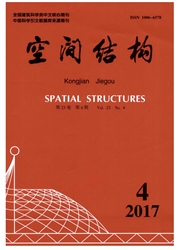

 中文摘要:
中文摘要:
火车站站台张弦桁架雨棚结构四面敞开,且结构中拉索在风荷载作用下容易松弛退出工作,因此该类结构对风荷载较为敏感.本文以北京北站站台张弦桁架雨棚为例,详细陈述了这类结构在抗风分析研究过程中所采用的方法和所得到的结论.首先通过数值风洞技术研究了北京北站张弦桁架结构表面的风载体型系数,发现四面敞开雨棚结构表面的风载体型系数分布与封闭式结构有着本质不同,且应同时考虑不同风向角及风攻角对风载体型系数分布的影响.随后根据线性滤波器的自回归法编制了脉动风时程模拟程序,计算得到了张弦桁架雨棚各节点的脉动风速时程,并结合第一步模拟所得的风载体型系数对结构进行了风致动力响应分析,得到了结构各节点的位移风振系数,并总结出一般规律.
 英文摘要:
英文摘要:
Truss string canopy on platform of railway station is an open-wide structure. The cable of the structure may fail to work under effect of wind-load. As a result the canopy is sensitive to wind load. The method and results of the wind resistance research of Beijing North Railway Station are presented in detail in the paper. Wind-load shape coefficient of the canopy is obtained by numerical simulation, which shows that distribution of shape coefficient is different between closed canopy and open-wide canopy, ancl is also different while the wind directions or angles are changed. A simulation program based on auto-regressive method is developed to simulate the time-history of wind velocity of all nodes on the canopy. Based on the shape coefficient and the time-history of wind velocity, wind-induced vibration response of the truss string structure is analyzed, and the wind vibration coefficient is obtained.
 同期刊论文项目
同期刊论文项目
 同项目期刊论文
同项目期刊论文
 A vector-form hybrid particle-element method for modeling and nonlinear shell analysis of thin membr
A vector-form hybrid particle-element method for modeling and nonlinear shell analysis of thin membr 期刊信息
期刊信息
